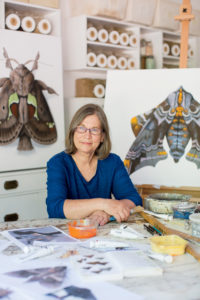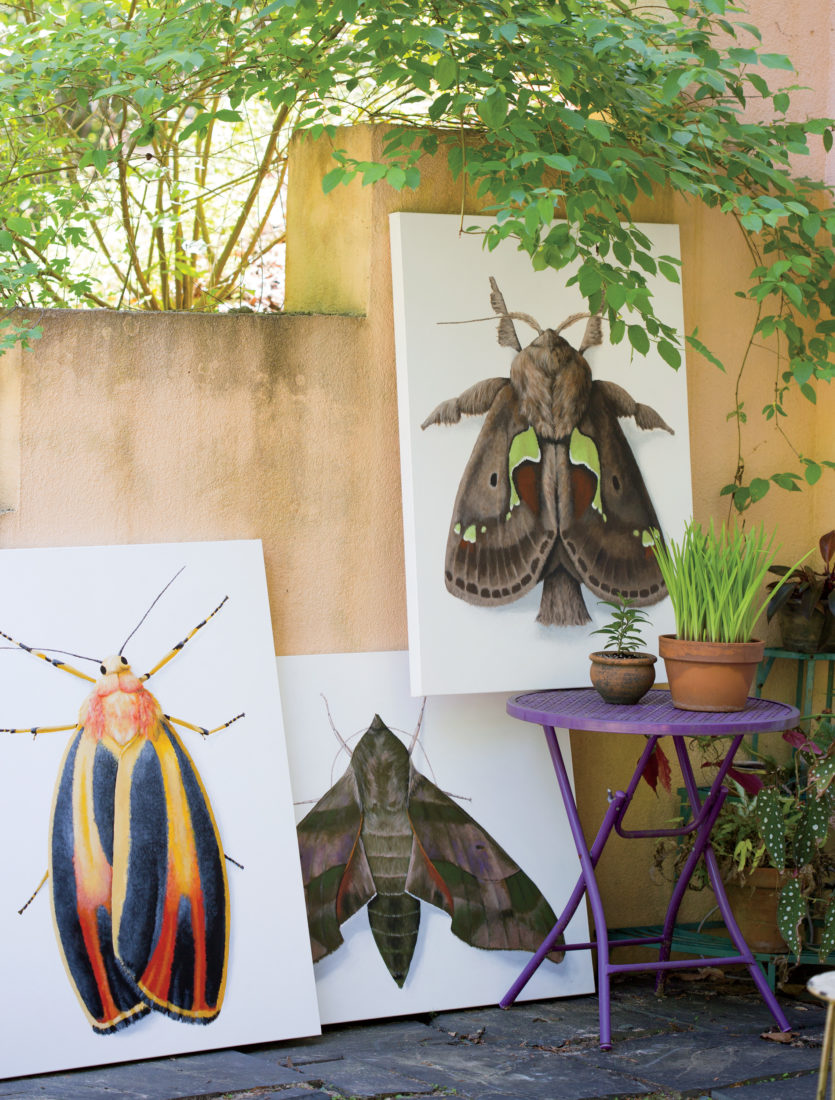In the inky darkness of a warm and windless night, deep in the woods outside of Charlottesville, Virginia, a white cloud of light glows. The outline of a shed reveals itself. Gravel crunches underfoot. Beside the shed stands a diminutive woman, a figure singular but not alone. Deborah Davis has a lot of company: hundreds of moths. Some of the insects cling to a white sheet lit with ultraviolet beams. Others flit about clumsily. They are random and rambunctious, bumping into Davis—one bounces off her face, another off her arm—as they take flight from and return to the fabric.
Davis extends an index finger toward a specimen on the sheet no more than an inch from wingtip to wingtip. “Baltimore snout moth,” she says. “I’ve painted this one.”
And many more. In the past six years, Davis, who is sixty-six, has rendered fifty or so lepidopteran species on canvas, and photographed nearly six hundred—all within fifty yards of her house. Her process is simple but ingenious. After dark she flicks on the UVs, one black and one white, which hang beside the sheet on the wall of her shed. She plucks a moth from the sheet, puts it in a pint jar, refrigerates the critter for a few hours to tranquilize it, photographs it with the macro lens of her Nikon D90, and then releases it back into the wild. After pulling up the image on the computer in her basement studio, she puts brush and acrylic paint to work, depicting the moth with astonishing precision, and in a deliberately contradictory way: big. Really big. She fills thirty-by-forty-inch canvases with magnified and meticulously executed paintings of the little insects, and lo and behold, the lowly moth takes on an almost regal bearing.

Photo: Patricia Lyons
Davis in her home studio in Virginia.
That attention to detail has earned Davis a level of fame in the mothing world, as well as showings at galleries, arboretums, universities, and botanical gardens. In the art world, a focus on moths is rare, says Barbara Buhr, the director of the Warm Springs Gallery in Virginia, which exhibited Davis’s work last year. The paintings “force us to rethink our standards of beauty,” Buhr says. “Those pesky, dull creatures that nibble away at our wool sweaters become alluring.” Doug Tallamy, a University of Delaware entomology professor who met Davis at the annual Mothapalooza conference, agrees. “Today so much of the public is disconnected from nature,” he says. “There is also a lot to be learned from looking at a faithful rendering of a moth, especially at that size.”
Which is exactly what Davis, who views herself as half artist, half naturalist, had in mind. Everything she’s done since she was a girl enamored with moths has led her to this place, this moment. After attending art school, she toiled in a camera shop, honing her photography skills, and painted jewelry, a task that sharpened her fine brushwork. Then she found success as a professional gardener.
Davis eventually bought a piece of land and built a house. One day when the home was under construction, she found a dead moth—a handsome azalea sphinx—on the floor. She decided to paint it. “I was pretty thrilled that first summer that I could identify fifty different moths here at the house, just from the porch light,” she says of her initial attempts at collecting live specimens. She graduated to her current setup, aided by the patchwork of native species in her garden, such as the Virginia creeper, oaks, and white pine that help draw the moths.
A recent night’s bounty included two massive lime-green luna moths, a species seldom seen: Their adult lives last only one week. Other moths appear less impressive at first glance. But when painted to scale by Davis, the locust underwing moth unfurls like an intricate hand fan, shades of coffee on the hind wing accented with bright orange bursts and fringed in light gray. The spiny oak slug moth reveals a lush shawl of umber fur. The triangular short-lined chocolate, in real life less than an inch long, looks positively royal, with wings like a sumptuous brown mink cape. All common, elevated to the extraordinary by Davis’s hand.








